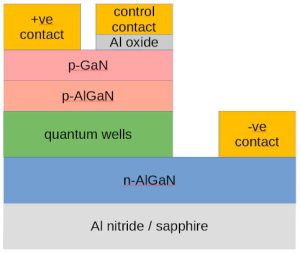They took the idea of driving an LED via a hybrid-T network, which combine ac and dc drive signals, one stage further, building a capacitively-coupled ac control electrode onto a conventional GaN LED structure.
The control electrode alters the number of holes in the p-GaN – Al2O3 region (see diagram), which varied from around 1016/cm3 with +10V on the extra electrode, up to ~1020/cm3 with -10V.
The extra electrode does not affect the colour of the output – it remains a 270nm UV LED – but it does modulate the light output somewhat – by ~17% if Electronics Weekly is reading the research correctly – the researches have been contacted to check this.
In practice, the positive contact and control contact are inter-digitated on the top surface of the device, whose active area measures 200 x 200μm.
To see how modulating the device via its third terminal compared with modulating a convention LED via an external hybrid-T network, the team build a similar sized conventional LED.
The three terminal version modulated up to ~263MHz, while the two-terminal version ran out of steam at ~160MHz.
Using 32, 16, 8, 4 and 2 QAM (quadrature amplitude modulation) the team managed to send up to 1.288Gbit/s across a short distance.
USTC worked with Fudan University, The Australian National University, King Abdullah University of Science and Technology, and Wuhan University.
The research has been published as ‘A three-terminal light emitting and detecting diode’ in Nature Electronics – only the abstract can be read without payment.

